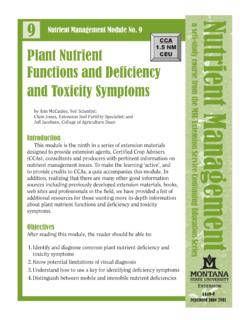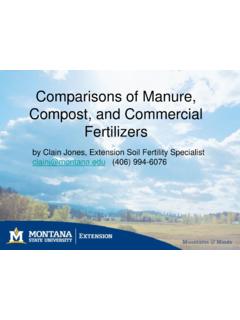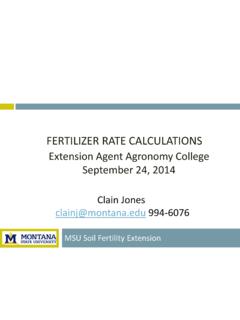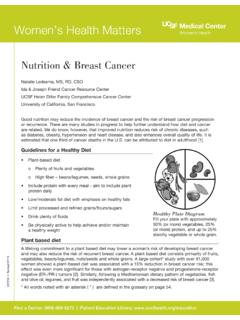Transcription of MODULE NO. 2 Plant Nutrition 1 and Soil Fertility
1 Sept. 2016 4449-2. NUTRIENT MANAGEMENT. NUTRIENT MANAGEMENT MODULE NO. 2. Plant Nutrition and Soil Fertility by Clain Jones, MSU Extension Soil Fertility Specialist, and Kathrin Olson-Rutz, Research Associate, INTRODUCTION. This MODULE is the second in a series of Extension materials designed to provide information on a variety of nutrient management issues to Extension agents, Certified Crop Advisers (CCAs), consultants, and producers. The Appendix at the end of this bulletin lists additional resources. OBJECTIVES. After reading this MODULE , the reader should: Know the 17 elements essential for Plant Nutrition . Know the macronutrients and micronutrients. Be familiar with the function and mobility of nutrients within plants .
2 Understand the forms of each nutrient that are taken up by plants . Be familiar with typical nutrient Plant concentrations. Be able to specify how nutrient needs change during the growing season. Understand the basics of nutrient uptake. Know how nutrients are held or released by the soil. CCA. NM. CEU. BACKGROUND classified as essential, the element needs to meet the following criteria: plants require 17 nutrients, also called -- The Plant cannot complete its life cycle (seed essential elements', which assist with different to new seed) without it. Plant functions for growth and reproduction. -- The element's function cannot be replaced Each Plant nutrient is needed in different by another element. amounts and varies in how mobile it is -- The element is directly involved in the Plant 's within the Plant and the soil.
3 It is useful to growth and reproduction. know the relative amount of each nutrient -- Most plants need this element to survive. that is needed by a crop in making fertilizer recommendations. In addition, understanding The fourth criterion is used because some Plant functions and mobility within the Plant specific plants need certain elements. For are useful in diagnosing nutrient deficiencies. example, cobalt (Co) is required by bacteria Soil characteristics that affect nutrient responsible for nitrogen (N) fixation in legumes;. availability to plants are also presented, as they therefore, Co is classified as beneficial', rather influence nutrient management decisions. than essential. Silica (Si) is not essential', but highly beneficial' to help plants cope with multiple stresses.
4 Other beneficial elements Plant Nutrition include sodium (Na) and vanadium (V). Essentiality is generally determined by growing ESSENTIAL ELEMENTS plants in nutrient solutions with or without a There are over 100 chemical elements, yet specific element, and observing differences in scientists have found that only 17 of them are Plant growth or function. Bear in mind that essential for Plant growth (Table 1). To be this approach is problematic for elements that TABLE 1. Essential element, role in Plant , and source. Element Role in Plant Source Carbon (C) Constituent of carbohydrates; necessary for photosynthesis Air Hydrogen (H) Maintains osmotic balance; important in numerous biochemical reactions; constituent of carbohydrates Water Oxygen (O) Constituent of carbohydrates, necessary for respiration Air/Water Nitrogen (N) Constituent of proteins, chlorophyll and nucleic acids Air/Soil Phosphorus (P) Constituent of many proteins, coenzymes, nucleic acids and metabolic substrates; important in energy Soil Potassium (K) Involved with photosynthesis, carbohydrate translocation, protein synthesis, etc.
5 Soil Calcium (Ca) A component of cell walls; plays a role in the structure and permeability of membranes Soil Magnesium (Mg) Enzyme activator, component of chlorophyll Soil Sulfur (S) Important component of Plant proteins Soil Boron (B) Believed to be important in sugar translocation and carbohydrate metabolism Soil Chlorine (Cl) Involved with oxygen production in photosynthesis Soil Copper (Cu) A catalyst for respiration; a component of various enzymes Soil Iron (Fe) Involved with chlorophyll synthesis and in enzymes for electron transfer Soil Manganese (Mn) Controls several oxidation-reduction systems and photosynthesis Soil Molybdenum (Mo) Involved with nitrogen fixation and transforming nitrate to ammonium Soil Nickel (Ni) Necessary for proper functioning of the enzyme, urease, and found to be necessary in seed germination Soil Zinc (Zn) Involved with enzyme systems that regulate various metabolic activities Soil 2 MODULE 2 plant nutrition and Soil Fertility may be required in only trace amounts, due to the difficulty in keeping all of a certain trace element out of the seed-nutrient solution, FIGURE 1.
6 The law of the minimum. especially when Plant seeds contain substantial Image adapted from amounts of many elements. It is possible that other elements essential for growth will be discovered at some point. A limited supply of one of the essential nutrients can limit crop yield, although other factors such as heat or water can also limit yield. The concept that one factor will generally limit yield, or the law of the minimum', is illustrated in Figure 1, where the height of water in the barrel represents crop yield. In this figure N is initially the factor that limits yield, but after N is supplied, phosphorus (P) levels control yield. FIGURE 2. Nutrient amounts in dried Plant material. NON-MINERAL NUTRIENTS.
7 Three elements, carbon (C), hydrogen (H), and N, P, K, S, 5% MACRO. oxygen (O), are considered to be non-mineral Ca, Mg nutrients because they are derived from air 94% C, H, O. and water, rather than from soil minerals. Although they represent approximately 95% B, Cu, Fe, Mn, Mo, Ni, Zn of Plant biomass, they are generally given little to 250 ppm each Water & air 1% MICRO. attention in Plant Nutrition because they are Cl almost always in sufficient supply (Figure 2). to MINERAL NUTRIENTS 1 ppm = 1 tsp of water in an Olympic-sized swimming pool The 14 mineral nutrients are classified as either macronutrients or micronutrients based Q& A1. on their Plant requirements (Q&A 1). There are six macronutrients: N, P, potassium (K), calcium (Ca), magnesium (Mg), and sulfur (S).
8 The macronutrients, N, P, and K, are often classified as primary' macronutrients, Most producers generally apply only N, P, because deficiencies of N, P, and K are more and K. Why is it important to learn about the common than the secondary' macronutrients, other 11 mineral nutrients? Ca, Mg, and S. The micronutrients include boron (B), chlorine (Cl), copper (Cu), As Table 2 (page 4) shows, all of the 14 mineral nutrients are taken up by the iron (Fe), manganese (Mn), molybdenum crop and then a portion is removed from the field at harvest. If these nutrients (Mo), nickel (Ni) and zinc (Zn). Most of the macronutrients represent - 5%, or 1,000- are not replaced by either commercial fertilizers or organic materials such as 50,000 parts per million (ppm), of dry Plant manure, the amount of each in the soil will decrease, potentially limiting crop tissue, whereas the micronutrients generally yield.
9 In Montana and Wyoming, besides N, P, and K, there are known cases comprise less than , or 250 ppm, of B, Cl, Cu, Fe, Mn, S, and Zn deficiencies. By knowing the nutrients that of dry Plant tissue (Table 2, page 4). The exception is Cl, a micronutrient which has could possibly affect yield, one can better diagnose and remedy crop nutrient Plant tissue concentrations similar to some deficiencies. MODULE 2 plant nutrition and Soil Fertility 3. of the macronutrients. Keep in mind that the be taken up by plants . Knowing what form of classifications of micro vs. macronutrient a nutrient the Plant absorbs helps us to better refer to Plant needs rather than Plant uptake understand what controls the movement of amounts.
10 For example, plants can take up that nutrient in soil. large amounts of Cl, yet plants need less Cl than the macronutrients, so it is classified as a micronutrient. Plant UPTAKE AND. Nutrients cannot be taken up by plants in REDISTRIBUTION OF. their elemental, or non-charged form, but NUTRIENTS instead are taken up in an ionic', or charged, Nutrient uptake by roots is dependent on both form (Table 2), with the exception of boric ability of the roots to absorb nutrients and acid which is uncharged. Most fertilizers are nutrient concentration at the surface of the root. made up of combinations of these available nutrient forms, so when the fertilizer dissolves, ROOTS. the nutrients can be immediately available for Roots are composed of both a mature uptake.










